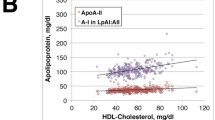Abstract
We have developed a sensitve, high-resolution method for the analysis of the apolipoprotein(a) [apo(a)] isoforms using sodium dodecyl sulfate (SDS)-agarose/ gradient polyacrylamide gel electrophoresis. In an analysis of the genetic polymorphism of apo(a) isoforms and their relationship with plasma lipoprotein(a) [Lp(a)] levels in Japanese and Chinese, this method identified 25 different apo(a) isoforms and detected one or two apo(a) isoforms in more than 99.5% of the individuals tested. The apparent molecular weights of the apo(a) isoforms ranged from 370 kDa to 950 kDa, and 22 of the 25 different apo(a) isoforns had a higher molecular weight than of apo B-100. Studies on Japanese families confirmed the autosomal codominant segregation of apo(a) isoforms and the existence of a null allele at the apo(a) locus. The observed frequency distribution of apo(a) isoform phenotypes fit the expectations of the Hardy-Weinberg equilibrium in both the Japanese and Chinese populations. Our data indicate the existence of at least 26 alleles, including a null allele, at the apo(a) locus. The frequency distribution patterns of the apo(a) isoform alleles in Japanese and Chinese were similar to each other and also similar to that of apo(a) gene sizes reported in Caucasian American individuals. The average heterozygosity at the apo(a) locus was 92% in Japanese and 93% in Chinese. A highly significant inverse correlation was observed between plasma Lp(a) levels and the size of apo(a) isoforms in both the Japanese (r=-0.677, P=0.0001) and the Chinese (r=-0.703, P=0.0001). A highly skewed distribution of Lp(a) concentrations towards lower levels in the Japanese population may be explained by high frequencies of alleles encoding large apo(a) isoforms and the null allele.
Similar content being viewed by others
References
Armstrong VW, Cremer P, Eberle E, Manke A, Schulze F, Wieland H, Kreuzer H, Seidel D (1986) The association between serum Lp(a) concentrations and angiographically assessed coronary atherosclerosis. Atherosclerosis 62: 249–257
Berg K, Dahlén G, Frick MH (1974) Lp(a) lipoprotein and pre-β1lipoprotein in patients with coronary heart disease. Clin Genet 6:230–235
Boerwinkle E, Leffert CC, Lin J, Lackner C, Chiesa G, Hobbs HH (1992) Apolipoprotein(a) gene accounts for greater than 90% of the variation in plasma lipoprotein(a) concentrations. J Clin Invest 90:52–60
Fless GM, ZumMallen ME, Scanu AM (1985) Isolation of apolipoprotein(a) from lipoprotein(a). J Lipid Res 26:1224–1229
Fless GM, ZumMallen ME, Scanu AM (1986) Physicochemical properties of apolipoprotein(a) and lipoprotein(a-) derived from the dissociation of human plasma lipoprotein(a). J Biol Chem 261:8712–8718
Gaubatz JW, Ghanem KI, Guevara JJ, Nava ML, Patsch W, Morrisett JD (1990) Polymorphic forms of human apolipoprotein(a): inheritance and relationship of their molecular weights to plasma levels of lipoprotein(a). J Lipid Res 31:603–613
Gavish D, Azrolan N, Breslow JL (1989) Plasma Lp(a) concentration is inversely correlated with the ratio of kringle IV/kringle V encoding domains in the apo(a) gene. J Clin Invest 84:2021–2027
Hixson JE, Britten ML, Manis GS, Rainwater DL (1989) Apolipoprotein(a) (apo(a)) glycoprotein isoforms result from size differences in apo(a) mRNA in baboons. J Biol Chem 264:6013–6016
Kamboh MI, Ferrell RE, Kottke BA (1991) Expressed hypervariable polymorphism of apolipoprotein(a). Am J Hum Genet 49:1063–1974
Koschinsky ML, Beisiegel U, Henne-Bruns D, Eaton DL, Lawn RM (1990) Apolipoprotein(a) size heterogeneity is related to variable number of repeat sequences in its mRNA. Biochemistry 29:640–644
Kraft HG, Köchl S, Menzel HJ, Sandholzer C, Utermann G (1992) The apolipoprotein(a) gene: a transcribed hypervariable locus controlling plasma lipoprotein(a) concentration. Hum Genet 90:220–230
Lackner C, Boerwinkle E, Leffert CC, Rahmig T, Hobbs HH (1991) Molecular basis of apolipoprotein(a) isoform size heterogeneity as revealed by pulsed-field gel electrophoresis. J Clin Invest 87:2077–2086
Laemmli UK (1970) Cleavage of structural proteins during the assembly of the head of bacteriophage T4. Nature 227:680–685
MBewu AD, Durrington PN (1990) Lipoprotein (a): structure, properties and possible involvement in thrombogenesis and atherogenesis. Atherosclerosis 85:1–14
McLean JW, Tomlinson JE, Kuang W-J, Eaton DL, Chen EY, Fless GM, Scanu AM, Lawn RM (1987) cDNA sequence of human apolipoprotein(a) is homologous to plasminogen. Nature 330:132–137
Murai A, Miyahara T, Fujimoto N, Matsuda M, Kameyama M (1986) Lp(a) lipoprotein as a risk factor for coronary heart disease and cerebral infarction. Atherosclerosis 59:199–204
Sandholzer C, Hallman DM, Saha N, Sigurdsson G, Lackner C, Császár A, Boerwinkle E, Utermann G (1991) Effects of the apolipoprotein(a) size polymorphism on the lipoprotein(a) concentration in 7 ethnic groups. Hum Genet 86:607–614
Scanu AM, Fless GM (1990) Lipoprotein(a): heterogeneity and biological relevance. J Clin Invest 85:1709–1715
Utermann G (1989) The mysteries of lipoprotein(a). Science 246:904–910
Utermann G, Menzel HJ, Kraft HG, Duba HC, Kemmler HG, Seitz C (1987) Lp(a) glycoprotein phenotypes: inheritance and relation to Lp(a)-Iipoprotein concentrations in plasma. J Clin Invest 80:458–465
Utermann G, Duba C, Menzel HJ (1988a) Genetics of the quantitative Lp(a) lipoprotein trait. II. Inheritance of Lp(a) glycoprotein phenotypes. Hum Genet 78:47–50
Utermann G, Kraft HG, Menzel HJ, Hopferwieser T, Seitz C (1988b) Genetics of the quantitative Lp(a) lipoprotein trait. I. Relation of Lp(a) glycoprotein phenotypes to Lp(a) lipoprotein concentration in plasma. Hum Genet 78:41–46
Yanagi H, Nakagawa A, Kikuchi S, Tanaka T, Tsuchiya S, Hamauchi H (1993) Frequent occurrence of familial aggregations of high lipoprotein(a) levels associated with small apolipoprotein(a) isoforms. Hum Genet 92:545–548
Yasuda N, Kimura M (1968) A gene-counting method of maximum likelihood for estimating gene frequencies in ABO and ABO-like systems. Ann Hum Genet 31:409–420
Author information
Authors and Affiliations
Rights and permissions
About this article
Cite this article
Kikuchi, S., Nakagawa, A., Kobayashi, K. et al. High degree of genetic polymorphism in apolipoprotein(a) associated with plasma lipoprotein(a) levels in Japanese and Chinese populations. Hum Genet 92, 537–544 (1993). https://doi.org/10.1007/BF00420935
Received:
Revised:
Issue Date:
DOI: https://doi.org/10.1007/BF00420935




